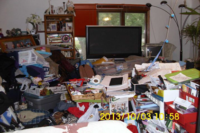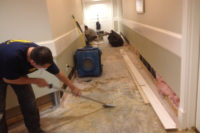Spoiled Food, Stacks of Old Papers and Millions of Cockroaches: A Hoarding Case Study






“Most hoarders are clean, formal, very pleasant people. You would never guess, if you met them in your office, that their house was packed to the gills.”
That’s Harry Allcroft, Owner, PuroClean of Delran (New Jersey), who has been working hoarding jobs – in addition to water and fire damage restoration, mold remediation and biohazard cleanup – since opening his franchise location in 2007. And this was largely the case when Allcroft was contacted in November 2013 to clean out a hoarded house in Philadelphia.
The home was a duplex, the upstairs serving as the living area of a retired orthopedic surgeon, while the downstairs served as his former medical practice. After receiving a letter from the city of Philadelphia Licenses & Inspection (L&I) indicating that an inspection was imminent, the homeowner had to make a decision – be evicted or change. With the support of his family and friends, he chose the latter option.
“Like most hoarders, they develop a stronger relationship with their things than they do with their family members,” says Allcroft. “And like most hoarders, they will not do anything unless there is some external pressure to change.”
The L&I letter served as the catalyst for change – and that’s when a friend of the homeowner’s called Allcroft. Along with more PuroClean workers from the location in Philadelphia, Allcroft and his team arrived to assess the property. The downstairs portion of the duplex was cluttered with mountains of old patient files and elsewhere around the home lied outdoor tools and power equipment, boxes of old books, cooking utensils, spoiled food, fishing equipment, old collectables and more deleterious debris – all piled up as to not interrupt an 18-inch lane that the homeowner used to maneuver from room to room.
Fit for TLCParts of the hoarding cleanup were also featured in a TV special about this hoarding case. The episode debuted on the TLC series “Hoarding: Buried Alive” on March 19. |
But what really made this hoarding project stand out and complicate things was the millions and millions of cockroaches that had infested the home. According to the homeowner, the hoard had started with clutter. Then the roaches invaded, the homeowner couldn’t control the infestation and he eventually grew accustomed to them. Piles of roach feces layered the tables and counters, making for unsanitary conditions and a serious health risk. What’s more is that with roaches everywhere, the feces was certain to stick to their legs and cross contaminate literally every inch of the home.
In December of 2013, Allcroft and his crew began cleaning out the house.
“The beginning of a hoarding project is always ironing out the logistics,” he says. “How many crew members are going to be able to be productive without getting into each other’s way? Where are your points of access?”
After deliberation, Allcroft broke crew members up into three teams of two. Wearing Tyvek suits, boots, double gloves and respirations, each team started at an entry point to the home – one at the front door, one at the back door and the other at the side door – and began cleaning it out.
In the meantime, Allcroft contacted an area dumpster company that he often uses, which sent two dumpsters and a driver to the home. After the cleaning crew filled one dumpster, it was hauled away allowing them to immediately begin filling the second one and get into a nice flow.
Most of the home’s materials were removed in one day, although the crew did return to the home the next two days to finalize the cleanup. After all the contents were removed, the next step was to clean and sanitize the property. But the cockroaches – and other varmint like mice and rats – that had invaded the home were deemed to have caused too much damage. The cost to completely restore the home – which will consist of also removing the drywall and cleaning and sanitizing down to the studs – was estimated to cost more than the equity on the house was worth.
The homeowner was moved into a retirement facility, where he’s now living happily and clutter-free, and the family is weighing its options on what to do with the home, which is salvageable should anyone be willing to take on the project.
“I really love this work,” says Allcroft. “(We’re) doing something to help them. He was living like this for years. He was sleeping in the bed that had holes in it and roaches coming in and out of it. He would wear long sleeves to bed so he wouldn’t feel them crawling on him. It was just so terribly unhealthy.”
Looking for a reprint of this article?
From high-res PDFs to custom plaques, order your copy today!











